Deck 17: Voltage Regulators
Question
Question
Question
Question
Question
Question
Question
Question
Question
Question
Question
Question
Question
Question
Question
Question
Question
Question
Question
Question
Question
Question
Question
Question
Question
Question
Question
Question
Question
Question
Question

Unlock Deck
Sign up to unlock the cards in this deck!
Unlock Deck
Unlock Deck
1/31
Play
Full screen (f)
Deck 17: Voltage Regulators
1
The 7912 produces a regulated output voltage of
A)+12 V.
B)+5 V.
C)- 12 V.
D)+9 V.
A)+12 V.
B)+5 V.
C)- 12 V.
D)+9 V.
C
2
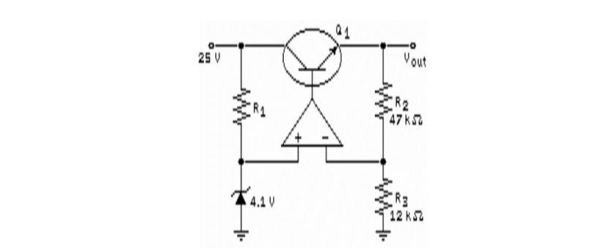
Refer to the figure above. This circuit is brought in for repair. The measured output voltage was 25 V under all load conditions. A possible cause of this symptom might be that
A)R3 has opened.
B)R2 has opened.
C)Q1 base- emitter has opened.
D)Vin has decreased.
B
3
Switching regulators have than linear regulators.
A)more heat- sinking requirements
B)simpler circuitry
C)greater efficiency
D)lower efficiency
A)more heat- sinking requirements
B)simpler circuitry
C)greater efficiency
D)lower efficiency
C
4
is a measurement of how well the power supply maintains a constant output voltage with changes in input voltage.
A)Load voltage control
B)Load regulation
C)Line regulation
D)Voltage control
A)Load voltage control
B)Load regulation
C)Line regulation
D)Voltage control

Unlock Deck
Unlock for access to all 31 flashcards in this deck.
Unlock Deck
k this deck
5
A voltage regulator with a no- load output dc voltage of 12 V is connect to a load with a resistance of 10 ▲. If the load resistance decreases to 7.5 ▲, the load voltage will decrease to 10.9 V. The load current will be and the percent load regulation is .
A)1.45 A, 10.09%
B)1.6 A, 90.8%
C)1.6 A, 9.17%
D)1.45 A, 90.8%
A)1.45 A, 10.09%
B)1.6 A, 90.8%
C)1.6 A, 9.17%
D)1.45 A, 90.8%

Unlock Deck
Unlock for access to all 31 flashcards in this deck.
Unlock Deck
k this deck
6
A 7805 regulator has a +20 V input. If the input and output pins of the regulator are shorted together by a solder bridge, the output voltage will be
A)0.7 V.
B)+20 V.
C)+5 V.
D)0 V.
A)0.7 V.
B)+20 V.
C)+5 V.
D)0 V.

Unlock Deck
Unlock for access to all 31 flashcards in this deck.
Unlock Deck
k this deck
7
A _ _ maintains a constant output voltage by controlling the duty cycle of a switch in series with the load.
A)shunt regulator
B)linear regulator
C)switching regulator
D)series regulator
A)shunt regulator
B)linear regulator
C)switching regulator
D)series regulator

Unlock Deck
Unlock for access to all 31 flashcards in this deck.
Unlock Deck
k this deck
8
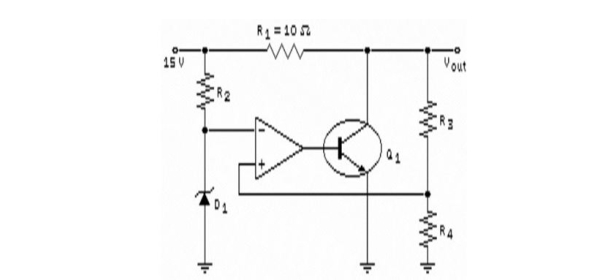
Refer to the figure above. The purpose for the diode D1 is to
A)sense the error signal.
B)amplify the error signal.
C)supply a reference voltage.
D)limit the input voltage to the circuit.

Unlock Deck
Unlock for access to all 31 flashcards in this deck.
Unlock Deck
k this deck
9
In a step- up regulator, the output voltage is filtered with a
A)diode.
B)choke- input filter.
C)capacitor- input filter.
D)voltage divider.
A)diode.
B)choke- input filter.
C)capacitor- input filter.
D)voltage divider.

Unlock Deck
Unlock for access to all 31 flashcards in this deck.
Unlock Deck
k this deck
10
The main difference between the 78XX and 79XX series regulators is that
A)the 78XX series is fixed and the 79XX series is adjustable.
B)the 78XX series is adjustable and the 79XX series is fixed.
C)the 78XX series provides a negative fixed output voltage and the 79XX series provides a positive fixed output voltage.
D)the 78XX series provides a positive fixed output voltage and the 79XX series provides a negative fixed output voltage.
A)the 78XX series is fixed and the 79XX series is adjustable.
B)the 78XX series is adjustable and the 79XX series is fixed.
C)the 78XX series provides a negative fixed output voltage and the 79XX series provides a positive fixed output voltage.
D)the 78XX series provides a positive fixed output voltage and the 79XX series provides a negative fixed output voltage.

Unlock Deck
Unlock for access to all 31 flashcards in this deck.
Unlock Deck
k this deck
11
If the output of a voltage regulator varies from 15 to 14.7 V between the minimum and maximum load current, the load regulation is
A)0.
B)2%.
C)1%.
D)5%.
A)0.
B)2%.
C)1%.
D)5%.

Unlock Deck
Unlock for access to all 31 flashcards in this deck.
Unlock Deck
k this deck
12
The LM317 regulator provides an)
A)adjustable negative output voltage.
B)fixed negative output voltage.
C)fixed positive output voltage.
D)adjustable positive output voltage.
A)adjustable negative output voltage.
B)fixed negative output voltage.
C)fixed positive output voltage.
D)adjustable positive output voltage.

Unlock Deck
Unlock for access to all 31 flashcards in this deck.
Unlock Deck
k this deck
13
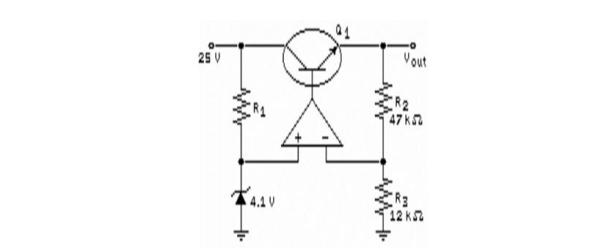
Refer to the figure above. If the zener had a voltage rating of 3.7 V, Vout would be
A)20.2 V.
B)25 V.
C)18.2 V.
D)7.1 V.

Unlock Deck
Unlock for access to all 31 flashcards in this deck.
Unlock Deck
k this deck
14
A voltage regulator with a no- load dc output of 15 V is connected to a load with a resistance of 12 ▲. If the load voltage decreases to 14.5 V, the percent regulation would be
A)96.7%.
B)100%.
C)3.45%.
D)3.33%.
A)96.7%.
B)100%.
C)3.45%.
D)3.33%.

Unlock Deck
Unlock for access to all 31 flashcards in this deck.
Unlock Deck
k this deck
15
Simple current limiting may produce too much heat in the
A)ambient air.
B)pass transistor.
C)zener diode.
D)load resistor.
A)ambient air.
B)pass transistor.
C)zener diode.
D)load resistor.

Unlock Deck
Unlock for access to all 31 flashcards in this deck.
Unlock Deck
k this deck
16
The 78XX series of voltage regulators produces an output voltage that is
A)positive.
B)either positive or negative.
C)negative.
D)unregulated.
A)positive.
B)either positive or negative.
C)negative.
D)unregulated.

Unlock Deck
Unlock for access to all 31 flashcards in this deck.
Unlock Deck
k this deck
17
Without current limiting, a shorted load will probably
A)destroy diodes and transistors.
B)have a load voltage equal to the zener voltage.
C)have too little load current.
D)produce zero load current.
A)destroy diodes and transistors.
B)have a load voltage equal to the zener voltage.
C)have too little load current.
D)produce zero load current.

Unlock Deck
Unlock for access to all 31 flashcards in this deck.
Unlock Deck
k this deck
18
To get more output voltage from a step- down switching regulator, you have to
A)increase the switching frequency.
B)increase the duty cycle.
C)decrease the input voltage.
D)decrease the duty cycle.
A)increase the switching frequency.
B)increase the duty cycle.
C)decrease the input voltage.
D)decrease the duty cycle.

Unlock Deck
Unlock for access to all 31 flashcards in this deck.
Unlock Deck
k this deck
19
If the load is shorted, the pass transistor has the least power dissipation when the regulator has
A)foldback limiting.
B)a high zener voltage.
C)buck topology.
D)low efficiency.
A)foldback limiting.
B)a high zener voltage.
C)buck topology.
D)low efficiency.

Unlock Deck
Unlock for access to all 31 flashcards in this deck.
Unlock Deck
k this deck
20
An increase of line voltage into a power supply usually produces
A)a decrease in efficiency.
B)a decrease in load resistance.
C)an increase in load voltage.
D)less power dissipation in the rectifier diodes.
A)a decrease in efficiency.
B)a decrease in load resistance.
C)an increase in load voltage.
D)less power dissipation in the rectifier diodes.

Unlock Deck
Unlock for access to all 31 flashcards in this deck.
Unlock Deck
k this deck
21
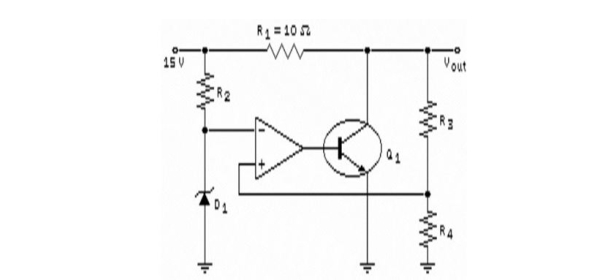
Refer to the figure above. To increase the current handling capability of this regulator, beyond the 5 A rating of the transistor, the reasonable thing to do would be to
A)increase the value of the zener diode.
B)change the values of R2 and R3.
C)place another transistor in series with Q1.
D)place another transistor in parallel with Q1.

Unlock Deck
Unlock for access to all 31 flashcards in this deck.
Unlock Deck
k this deck
22
A series regulator is an example of a
A)ac- to- dc converter.
B)switching regulator.
C)shunt regulator.
D)linear regulator.
A)ac- to- dc converter.
B)switching regulator.
C)shunt regulator.
D)linear regulator.

Unlock Deck
Unlock for access to all 31 flashcards in this deck.
Unlock Deck
k this deck
23
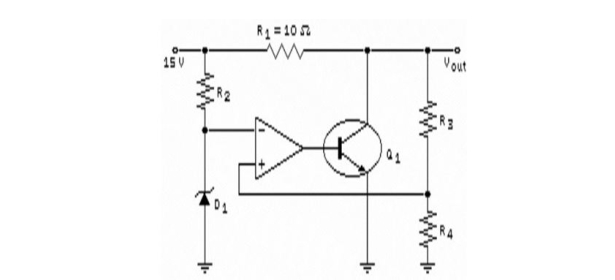
Refer to the figure above. The purpose for the op- amp is to
A)supply a reference voltage.
B)limit the input voltage to the circuit.
C)amplify the error signal.
D)sense the error signal.

Unlock Deck
Unlock for access to all 31 flashcards in this deck.
Unlock Deck
k this deck
24
An advantage of shunt regulation is
A)little wasted power.
B)built- in short- circuit protection.
C)high efficiency.
D)low power dissipation in the pass transistor.
A)little wasted power.
B)built- in short- circuit protection.
C)high efficiency.
D)low power dissipation in the pass transistor.

Unlock Deck
Unlock for access to all 31 flashcards in this deck.
Unlock Deck
k this deck
25
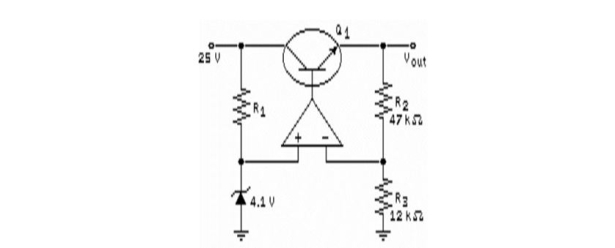
Refer to the figure above. If a solder splash shorted the ends of R1 to each other, the result would be that
A)Q1 would open.
B)the output voltage would not change.
C)the op- amp would fail.
D)the zener would fail.

Unlock Deck
Unlock for access to all 31 flashcards in this deck.
Unlock Deck
k this deck
26

Refer to the figure above. An increase in VOUT will cause Q1 to
A)conduct less.
B)open.
C)conduct the same.
D)conduct more.

Unlock Deck
Unlock for access to all 31 flashcards in this deck.
Unlock Deck
k this deck
27
An advantage of a switching regulator is
A)the circuit is very efficient.
B)less heat and wasted power.
C)voltages can be stepped- up or stepped- down.
D)All of the above.
E)None of the above.
A)the circuit is very efficient.
B)less heat and wasted power.
C)voltages can be stepped- up or stepped- down.
D)All of the above.
E)None of the above.

Unlock Deck
Unlock for access to all 31 flashcards in this deck.
Unlock Deck
k this deck
28
If the output of a voltage regulator varies from 20 to 19.8 V when the line voltage varies over its specified range, the load regulation is
A)2%.
B)5%.
C)0.
D)1%.
A)2%.
B)5%.
C)0.
D)1%.

Unlock Deck
Unlock for access to all 31 flashcards in this deck.
Unlock Deck
k this deck
29
Switching regulator configurations include
A)step- up.
B)inverting.
C)step- down.
D)All of the above.
A)step- up.
B)inverting.
C)step- down.
D)All of the above.

Unlock Deck
Unlock for access to all 31 flashcards in this deck.
Unlock Deck
k this deck
30
With foldback current limiting, the load voltage approaches zero, and the load current approaches
A)the zener current.
B)a destructive level.
C)infinity.
D)a small value.
A)the zener current.
B)a destructive level.
C)infinity.
D)a small value.

Unlock Deck
Unlock for access to all 31 flashcards in this deck.
Unlock Deck
k this deck
31
A voltage regulator has a no- load output of 18 V and a full load output of 17.3 V. The percent load regulation is
A)1.04%.
B)96.1%.
C)4.05%.
D)0.25%.
A)1.04%.
B)96.1%.
C)4.05%.
D)0.25%.

Unlock Deck
Unlock for access to all 31 flashcards in this deck.
Unlock Deck
k this deck



